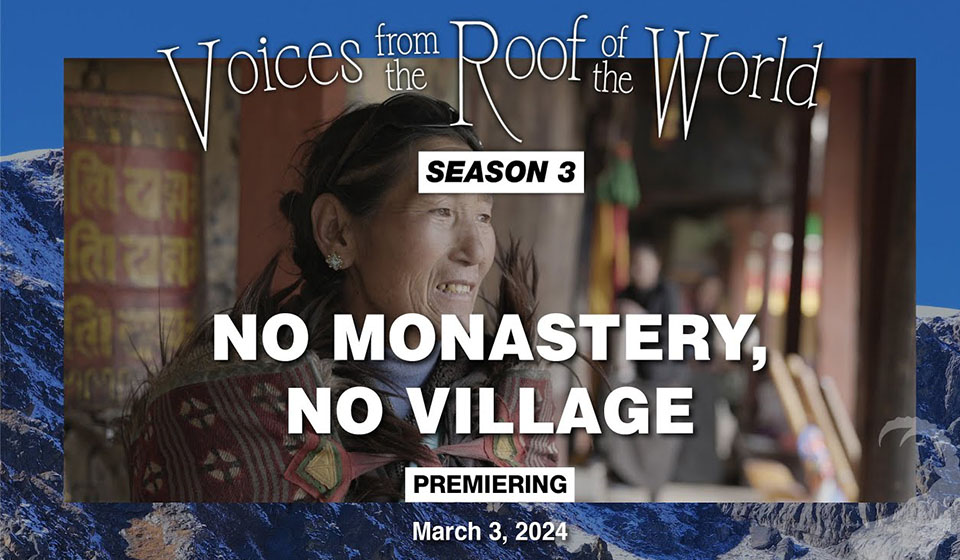Solidarity and Resilience, Two pillars
5 months ago
The author is a third-year student of Media Studies at Kathmandu University School of Arts

5 months ago

The winner of kimff 2024 Awards "No Monastery, No Village" is a powerful documentary that takes us into the heart of Halji, an isolated village in Nepal connected to the historic Waltse Rinchenling Buddhist Monastery. The documentary, directed by Tashi Lhajom and produced by Andrew Tkach, delivers a story of a community that has existed since the 11th century.
With a population of only 500, the village's survival depends on the monastery, not merely as a place of worship, but also as a cultural landmark that survived the test of time. The approaching threat of a natural disaster provides a major narrative drive, highlighting the vulnerability of this traditional way of life in the face of climate change.
As the story progresses, the growing closeness between the villagers and the monastery becomes evident. The documentary effectively depicts the growing threat of a glacier situated a few km above, which could soon release a flood that might erase Halji's history and destroy those who live there. The documentary powerfully depicts people torn between survival and preserving their way of life. As the documentary unfolds, the connection between the villagers and the monastery deepens.
One particularly striking example is Pema Dolpa, a single mother of three daughters. She managed livestock until a massive avalanche in 2013 reshaped her entire world. She has since sent her children to Kathmandu, moving them away from the traditional animal husbandry that she and her ancestors practised. Yet, she remains in the village, drawn by the monastery. Her faith in Vairocana Buddha is profound, and she cannot imagine living away from her deity. Her story is a powerful testament to the strength derived from faith and tradition.
On November 11, 2023, the religious leader of Halzi Monastery convened a village meeting to address a critical question: How can their ancient monastery be saved from the threat of rapid climate change? The community meetings held within the monastery walls are powerful, with both old and young voices passionately speaking about their determination to safeguard their way of life. The elders recount tales of past calamities where the monastery provided refuge and strength, reinforcing their resolve not to abandon it.
Almost unanimously, the Halzi villagers decide to stay and protect their sacred monastery, hoping their devotion can preserve their cultural heritage against the global threat of global warming.
Through beautiful cinematography, "No Monastery, No Village" not only captures the beauty of the Himalayan landscape but also the profound human spirit of the Halzi villagers. This documentary is a heartfelt story of a people bound by faith and love for their land, facing an uncertain future with hope and unity. It encourages viewers to consider the wider effects of environmental changes, as well as the significant losses that may result if these issues are not addressed.
Watching "No Monastery, No Village," I felt drawn into the world of Halji, observing the community’s deep bond with their monastery. It leaves a lasting impression, urging viewers to think about the challenges faced by communities around the world because of climate change.
Climate change affects everyone across the globe, but its impacts are most severe on vulnerable communities that contribute the least to its cause. Documentaries like "No Monastery, No Village" are essential because they highlight the human aspects of this global issue. By focusing on specific communities, such as the village of Halji in Nepal, these films show the effects of climate change on real people and their ways of life, making the issue more relatable and urgent for viewers.
Remote villages like Halji are particularly vulnerable because it's hidden from the global site, receiving little attention and support to deal with potential disasters like floods from melting glaciers nearby. This lack of visibility increases their risk, as there are minimal resources available to help them adapt and protect themselves.
The documentary "No Monastery, No Village" is important because it brings Halji's situation to light, attracting global attention and empathy that could lead to assistance and action. While Halji's remoteness has helped to preserve its traditional way of life, it has also made it more difficult to obtain the assistance it requires in dealing with environmental concerns. The documentary serves as a bridge, bringing this little-known community to a larger audience and emphasizing the importance of taking action to help such remote people cope with the effects of climate change.
I believe these documentaries are powerful tools. They connect us emotionally to places and people far away, transforming dry statistics into stories of human resilience. This connection can motivate viewers to support protective policies and adopt more sustainable practices in their own lives.
These films can push for action by showcasing how communities adapt and come together in the face of environmental threats. They are more than just educational; they are a call to action to preserve our shared humanity and support those most affected by climate change.
_20220508065243.jpg)
- by Mimansak Nepal


- by Sanskriti Pokharel

- by Republica
Leave A Comment